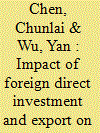|
|
|
Sort Order |
|
|
|
Items / Page
|
|
|
|
|
|
|
| Srl | Item |
| 1 |
ID:
113688


|
|
|
|
|
| Publication |
2012.
|
| Summary/Abstract |
This article examines the effect of GDP growth on bank profitability in China over the period 2003-2009. The one-step system GMM estimator is used to test the persistence of profitability in the Chinese banking industry. The empirical findings suggest that cost efficiency is positively related to bank profitability, while lower profitability can also be explained by higher taxes paid by banks. In addition, there is a negative relationship between GDP growth and bank profitability. Furthermore, the results show that (1) the profitability in the Chinese banking industry is significantly affected by the level of non-performing loans, and (2) Chinese banks with higher levels of capital have lower profitability. Finally, we find that the departure from a perfectly competitive market structure in the Chinese banking industry is relatively small.
|
|
|
|
|
|
|
|
|
|
|
|
|
|
|
|
| 2 |
ID:
152512


|
|
|
|
|
| Summary/Abstract |
This paper examines and compares the profitability of banks in the USA and China. The USA has the largest market-based banking system and the financial system of China is still bank-based. Our analysis indicates that in terms of profitability, banks in China outperformed those in the USA during our study period (2008–2014). Real estate loans had an adverse effect on US bank profitability during the financial crisis and no effect after the crisis but consistently improved the profitability of Chinese banks. Interest margins have no effect on US bank profitability but a consistently positive effect on Chinese banks, confirming that China is a traditional bank-based economy. Interbank loans have a positive and significant effect on Chinese bank profitability, while interbank domestic loans have a negative effect on US bank profitability. Finally, size had a positive effect on US banks after the financial crisis period, confirming the scale economies of large US banks, but a negative effect on Chinese banks, indicating diseconomies of scale.
|
|
|
|
|
|
|
|
|
|
|
|
|
|
|
|
| 3 |
ID:
114601


|
|
|
|
|
| Publication |
2012.
|
| Summary/Abstract |
This study seeks to examine the performance of 77 Bangladeshi, Sri Lankan, and Pakistani commercial banks between 1997 and 2008. The empirical findings suggest that bank specific characteristics - in particular, liquidity, non-interest income, credit risk, and capitalization - have positive and significant impacts on bank performance, while cost is negatively related to bank profitability. As for the impact of macroeconomic indicators, the results suggest that economic growth has positive and significant impact, while inflation has no significant impact on bank profitability. During the period under study, the empirical findings indicate that private investment is positively related to bank profitability, while private consumption expenditure exhibits negative impact. However, the impact is not uniform across the countries studied.
|
|
|
|
|
|
|
|
|
|
|
|
|
|
|
|
| 4 |
ID:
152511


|
|
|
|
|
| Summary/Abstract |
This paper investigates the impact of foreign direct investment (FDI) and exports on urbanization in China. Using prefecture city-level panel data covering China's 262 prefecture cities for the period 2004–2013 and employing a dynamic panel system generalized method of moments model with instrumental variable regression techniques, our study finds that FDI and exports have, on average, played a significantly positive role in China's urbanization. However, the impacts of FDI and exports on urbanization vary across regions. FDI has a positive and significant impact on urbanization in the coastal region but has no impact on urbanization in the inland region. Exports have a positive and significant impact on urbanization in both the coastal and inland regions, but the effect is much larger in the coastal region than in the inland region. The results imply that further attracting FDI inflows and promoting exports will contribute to China's urbanization, especially for the inland region.
|
|
|
|
|
|
|
|
|
|
|
|
|
|
|
|
|
|
|
|
|